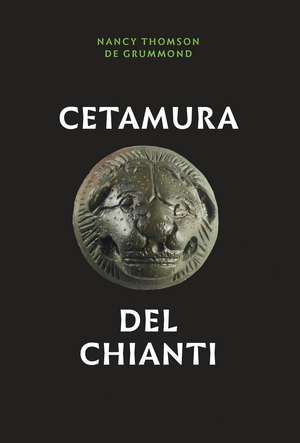Cetamura del Chianti: Cities and Communities of the Etruscans
Autor Nancy Thomson de Grummonden Limba Engleză Hardback – 10 ian 2020
Situated in an ideal hilltop location that was easy to defend and had access to fresh water, clay, and timber, the community never grew to the size of a city, and no known references to it survive in ancient writings; its ancient name isn’t even known. Because no cities were ever built on top of the site, excavation is unusually unimpeded. Intriguing features described in Cetamura del Chianti include an artisans’ zone with an adjoining sanctuary, which fostered the cult worship of Lur and Leinth, two relatively little known Etruscan deities, and ancient wells that reveal the cultural development and natural environment, including the vineyards and oak forests of Chianti, over a period of some six hundred years. Deeply enhancing our understanding of an intriguing economic, political, and cultural environment, this is a compelling portrait of a singular society.
Preț: 526.49 lei
Preț vechi: 683.76 lei
-23% Nou
Puncte Express: 790
Preț estimativ în valută:
100.76€ • 109.41$ • 84.63£
100.76€ • 109.41$ • 84.63£
Carte tipărită la comandă
Livrare economică 22 aprilie-06 mai
Preluare comenzi: 021 569.72.76
Specificații
ISBN-13: 9781477319109
ISBN-10: 1477319107
Pagini: 176
Ilustrații: 108 b&w photos, 7 b&w maps
Dimensiuni: 140 x 216 x 10 mm
Greutate: 0.34 kg
Editura: University of Texas Press
Colecția University of Texas Press
Seria Cities and Communities of the Etruscans
ISBN-10: 1477319107
Pagini: 176
Ilustrații: 108 b&w photos, 7 b&w maps
Dimensiuni: 140 x 216 x 10 mm
Greutate: 0.34 kg
Editura: University of Texas Press
Colecția University of Texas Press
Seria Cities and Communities of the Etruscans
Notă biografică
Nancy Thomson de Grummond is M. Lynette Thompson Distinguished Research Professor of Classics at Florida State University, director of excavations at Cetamura del Chianti, and coeditor of The Religion of the Etruscans and Caere.
Cuprins
- List of Illustrations
- Foreword
- Preface and Acknowledgments
- Album of Maps
- Chapter 1. Introduction
- Chapter 2. Early and Middle Etruscan Periods (Seventh–Fourth Centuries BCE)
- Bucchero Pottery
- A Ritual Crevice
- Chapter 3. Late Etruscan Phase I (300–150 BCE)
- Two Wells
- The Artisans’ Quarter
- Structure K: Making Brick and Tile
- Structures B and C: Water Management and Textile Production
- Structure J: A Workers’ Platform
- Structure N: Iron Working
- Pottery: A Typology
- Artifacts in the Artisans’ Quarter
- Fauna and Flora
- Conclusion
- Chapter 4. Late Etruscan Phase II (ca. 150–75/50 BCE)
- Structures A, B, and D
- Artifacts from Structures A and B
- Building L: The Sanctuary of the Etruscan Artisans
- Votive Features of Building L
- Chapter 5. The Wells of Cetamura: From Etruscan to Roman
- Well #2 (Structure M), on Zone II
- Well #1, on Zone I
- Chapter 6. Roman Cetamura (ca. 50 BCE to Late Antiquity)
- The Settlement of a Roman Veteran
- Baths and Production
- The Early Roman Empire
- The Later Roman Empire
- Chapter 7. Cetamura as a Community
- Chapter 8. Cetamura after Antiquity
- Appendix. A Timeline of History for Cetamura del Chianti
- Notes
- References
- Index
Recenzii
[<i>Cetamura del Chianti</i> is] a model introduction to a small site and to the scholarly task of drawing connections between the micro and the macro...Cetamura is a case study of an artisan community and its infrastructure that could usefully inform more exploration of this phenomenon in Etruria...this is a book and a site with much to offer.
This volume presents evidence from Cetamura in an accessible manner. It is best suited for students new to Etruscan archaeology and helps to broaden the discipline’s scope by focusing on a non-elite, rural community. Moreover, this volume underscores the value of rigorous palaeobotanical research.
[A] well-written study on the small hilltop settlement of Cetamura del Chianti in central Tuscany...[Cetamura del Chianti] provides an excellent example of how the evolution of a small Etruscan community can be described and understood effectively based on several decades of systematic research and archaeological excavation...This book, worthy in a multitude of ways, offers new insights into large and complex issues, seen from the unusual but fascinating and precisely described perspective of a small community, strengthening a type of archaeological and cultural analysis which will surely benefit from further development in the coming years.
[Cetamura del Chianti has] much to offer scholars, students, and the general public interested in the intersections of archaeology, history, material culture, and science as it pertains to a unique settlement that flourished between 300 BCE and 300 CE in the Chianti countryside.
Descriere
A rare glimpse into an ancient Etruscan community that provides evidence for how smaller communities could flourish despite centuries of nearby wars with the Romans.




